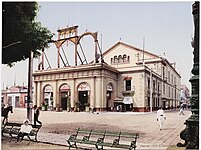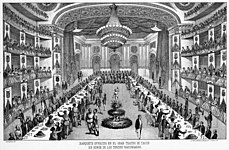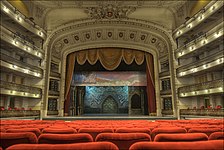Tacón Theatre: Difference between revisions
No edit summary Tag: Reverted |
No edit summary Tag: Reverted |
||
| Line 108: | Line 108: | ||
The '''Teatro Tacón''' (Tacón Theatre) opened in 1838 in [[Havana]], [[Cuba]]. Its auditorium contained 2,750 seats.<ref>{{cite book|author= Leopoldo Fornés Bonavía |title=Cuba, cronología: cinco siglos de historia, política y cultura|url=https://books.google.com/books?id=lJduKDMU8pcC|year= 2003|publisher={{Interlanguage link multi|Editorial Verbum|es}} |location=Madrid |isbn=978-84-7962-248-0 |language=es }}</ref> It was built by {{Interlanguage link multi|Pancho Martí|ca|3=Francesc Martí i Torrents}}, a businessman from Barcelona who moved to Havana, and named after [[Miguel Tacón y Rosique]], Governor of Cuba from 1834 to 1838.{{sfn|Ramírez|1891}}<ref name="Sublette2007">{{cite book|author= Ned Sublette|author-link= Ned Sublette|title=Cuba and Its Music: From the First Drums to the Mambo|url=https://books.google.com/books?id=fZZ4QKZEumIC|year= 2004|publisher=Chicago Review Press|isbn=978-1-56976-420-6}}</ref> In 1847 [[Giovanni Bottesini|Bottesini]]'s opera [[Cristoforo Colombo (opera)|''Cristoforo Colombo'']] premiered there.<ref>{{citation |author=Robert Murrell Stevenson |author-link=Robert Stevenson (musicologist) |chapter=Havana |title=New Grove Dictionary of Opera |location= New York |year= 1992 |isbn=0935859926 }}</ref> By 1855, so many people attended events that the city issued parking regulations for [[carriages]] on performance nights.<ref>{{cite book|title=Ordenanzas municipales de la ciudad de La Habana|url=https://archive.org/details/ordenanzasmunic01cubgoog|year=1855|publisher=Imprenta del gobierno y capitania general |language=es |chapter=Art.169-175 }}</ref> |
The '''Teatro Tacón''' (Tacón Theatre) opened in 1838 in [[Havana]], [[Cuba]]. Its auditorium contained 2,750 seats.<ref>{{cite book|author= Leopoldo Fornés Bonavía |title=Cuba, cronología: cinco siglos de historia, política y cultura|url=https://books.google.com/books?id=lJduKDMU8pcC|year= 2003|publisher={{Interlanguage link multi|Editorial Verbum|es}} |location=Madrid |isbn=978-84-7962-248-0 |language=es }}</ref> It was built by {{Interlanguage link multi|Pancho Martí|ca|3=Francesc Martí i Torrents}}, a businessman from Barcelona who moved to Havana, and named after [[Miguel Tacón y Rosique]], Governor of Cuba from 1834 to 1838.{{sfn|Ramírez|1891}}<ref name="Sublette2007">{{cite book|author= Ned Sublette|author-link= Ned Sublette|title=Cuba and Its Music: From the First Drums to the Mambo|url=https://books.google.com/books?id=fZZ4QKZEumIC|year= 2004|publisher=Chicago Review Press|isbn=978-1-56976-420-6}}</ref> In 1847 [[Giovanni Bottesini|Bottesini]]'s opera [[Cristoforo Colombo (opera)|''Cristoforo Colombo'']] premiered there.<ref>{{citation |author=Robert Murrell Stevenson |author-link=Robert Stevenson (musicologist) |chapter=Havana |title=New Grove Dictionary of Opera |location= New York |year= 1992 |isbn=0935859926 }}</ref> By 1855, so many people attended events that the city issued parking regulations for [[carriages]] on performance nights.<ref>{{cite book|title=Ordenanzas municipales de la ciudad de La Habana|url=https://archive.org/details/ordenanzasmunic01cubgoog|year=1855|publisher=Imprenta del gobierno y capitania general |language=es |chapter=Art.169-175 }}</ref> |
||
The Teatro Tacón was at the time, was world-famous, this theater is remembered because the Italian inventor of the |
The Teatro Tacón was at the time, was world-famous, this theater is remembered because the Italian inventor of the world's first telephone [[Antonio Meucci]], was commissioned and rebuilt the Gran Teatro de Tacón, in the years that he lived in Havana.<ref name="museoaica.it">{{cite web |url=http://www.museoaica.it/Museo_Aica/esplora/fili/pdf/12_Meucciday3.pdf |last=Catania |first=Basilio |title=Antonio Meucci, l'inventore del telefono |work=Notiziario Tecnico Telecom Italia |volume=12 |number=1 |date=December 2003 |language=IT |pages=109–117 |url-status=dead |archive-url=https://web.archive.org/web/20070702204022/http://www.museoaica.it/Museo_Aica/esplora/fili/pdf/12_Meucciday3.pdf |archive-date=2 July 2007}}</ref><ref>Meucci, Sandra. [https://archive.org/details/antonioelectrics00meuc ''Antonio and the Electric Scream: The Man Who Invented the Telephone''], Branden Books, Boston, 2010; {{ISBN|978-0-8283-2197-6}}, pp. 15–21, 24, 36–37, 47–52, 70–73, 92, 98, 100.</ref> |
||
==Architecture== |
==Architecture== |
||
Revision as of 21:18, 9 October 2023
| Tacón Theatre | |
|---|---|
 | |
 | |
| General information | |
| Coordinates | 23°08′13″N 82°21′33″W / 23.137039°N 82.359289°W |

The Teatro Tacón (Tacón Theatre) opened in 1838 in Havana, Cuba. Its auditorium contained 2,750 seats.[1] It was built by Pancho Martí, a businessman from Barcelona who moved to Havana, and named after Miguel Tacón y Rosique, Governor of Cuba from 1834 to 1838.[2][3] In 1847 Bottesini's opera Cristoforo Colombo premiered there.[4] By 1855, so many people attended events that the city issued parking regulations for carriages on performance nights.[5]
The Teatro Tacón was at the time, was world-famous, this theater is remembered because the Italian inventor of the world's first telephone Antonio Meucci, was commissioned and rebuilt the Gran Teatro de Tacón, in the years that he lived in Havana.[6][7]
Architecture
The Teatro Tacón had excellent acoustics, so much so that the Gran Teatro de La Habana was built around its old hall. Architect Paul Belau and U.S. firm Purdy and Henderson, Engineers kept the original structure and built the Centro Gallego (Galician Center), a European-styled addition and renovation for the purpose of enlarging its functions as well as serving as a means of introducing an elaborate system of circulation into an otherwise simple, and architecturally modest, preexisting box.
Gallery
-
Teatro Tacón, Havana, 1900, published by the Detroit Photographic Company. Beinecke Rare Book & Manuscript Library.
-
Teatro Tacón and part of the Paseo de Isabel II, in 1848 by Frédéric Mialhe
-
Teatro Tacón
-
Gran Teatro de La Habana
-
Teatro de Tacón and part of the Paseo de Isabel II, Havana, in 1855 by Frédéric Mialhe.
-
Back of the original theatre at Calles San Rafael and Consulado
See also
References
- ^ Leopoldo Fornés Bonavía (2003). Cuba, cronología: cinco siglos de historia, política y cultura (in Spanish). Madrid: Editorial Verbum. ISBN 978-84-7962-248-0.
- ^ Ramírez 1891.
- ^ Ned Sublette (2004). Cuba and Its Music: From the First Drums to the Mambo. Chicago Review Press. ISBN 978-1-56976-420-6.
- ^ Robert Murrell Stevenson (1992), "Havana", New Grove Dictionary of Opera, New York, ISBN 0935859926
{{citation}}: CS1 maint: location missing publisher (link) - ^ "Art.169-175". Ordenanzas municipales de la ciudad de La Habana (in Spanish). Imprenta del gobierno y capitania general. 1855.
- ^ Catania, Basilio (December 2003). "Antonio Meucci, l'inventore del telefono" (PDF). Notiziario Tecnico Telecom Italia (in Italian). pp. 109–117. Archived from the original (PDF) on 2 July 2007.
- ^ Meucci, Sandra. Antonio and the Electric Scream: The Man Who Invented the Telephone, Branden Books, Boston, 2010; ISBN 978-0-8283-2197-6, pp. 15–21, 24, 36–37, 47–52, 70–73, 92, 98, 100.
- ^ "Frédéric Mialhe". British Museum website.
- ^ "EARLY LITHOGRAPHED VIEWS OF HAVANA". University çof Florida Digital Collections website.
Bibliography
- Jacobo de la Pezuela (1863). "Habana: Edificios de Recreo: Teatro de Tacon". Diccionario geografico, estadístico, historico, de la isla de Cuba (in Spanish). Vol. 3. Madrid: Mellado.
- Serafín Ramírez (1891). "De 1830 a 1840". La Habana artística: Apuntes históricos (in Spanish). Havana: Imp. del E. M. de la Capitanía General. pp. 133+. (+ Theater programs, p. 657-660)



![Teatro Tacón, later version: colored, in 1839 by Frédéric Mialhe:[8][9]](http://upload.wikimedia.org/wikipedia/commons/thumb/5/57/Tac%C3%B3n_Theatre%2C_1839%2C_by_Fr%C3%A9d%C3%A9ric_Mialhe_-_Havana.jpg/243px-Tac%C3%B3n_Theatre%2C_1839%2C_by_Fr%C3%A9d%C3%A9ric_Mialhe_-_Havana.jpg)




